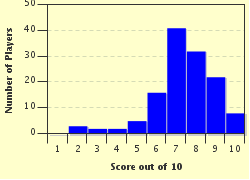Quiz Answer Key and Fun Facts
1. Christiane Nüsslein-Volhard shared a Nobel Prize in Physiology or Medicine in 1995 for her research concerning genetic control of embryonic development. What model organism, often used for its quick generation time, was used in the study?
2. Elizabeth Blackwell's status as the first woman to receive a medical degree in the United States is well known, however, how was she able to be accepted into medical school?
3. Gertrude Elion, a pharmacologist, developed all of the drugs with the EXCEPTION of which of the following?
4. In 1986, Rita Levi-Montalcini shared a Nobel Prize in Physiology or Medicine jointly with Stanley Cohen for their discovery of NGF. In this case, what does NGF mean?
5. Overshadowed, perhaps, by her more famous brother, who was the first female to discover a comet?
6. Virginia Apgar, the first woman to become a full professor at Columbia University College of Physicians and Surgeons, gave her name to a test used to determine which of the following?
7. Rachel Carson is well-known for her book, "Silent Spring", which made the American public aware of environmental concerns. The book led to the subsequent ban of which dangerous pesticide in the United States?
8. The second female Nobel laureate in physics, Maria Goeppert Mayer worked for which prestigious group during World War II?
9. Jane Goodall's fifty-five year study of animal behavior in the Gombe Stream National Park in Tanzania has led to her recognition of being the world's foremost expert on the behavior of which of the following?
10. As of the end of the twentieth century, which of the following sentences best describes the accomplishments of Marie Curie?
Source: Author
ponycargirl
This quiz was reviewed by FunTrivia editor
bloomsby before going online.
Any errors found in FunTrivia content are routinely corrected through our feedback system.

